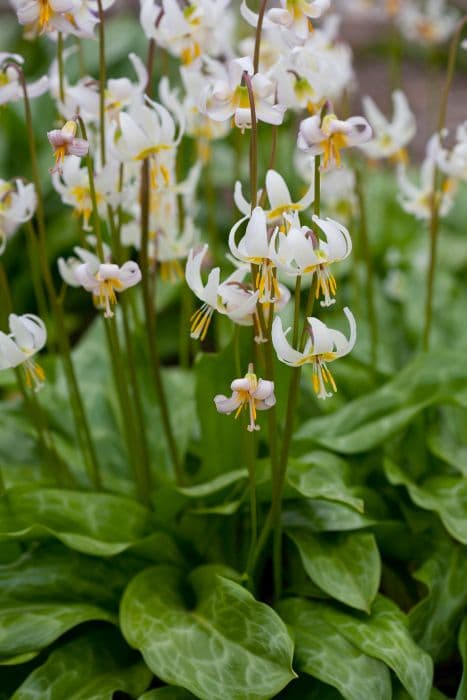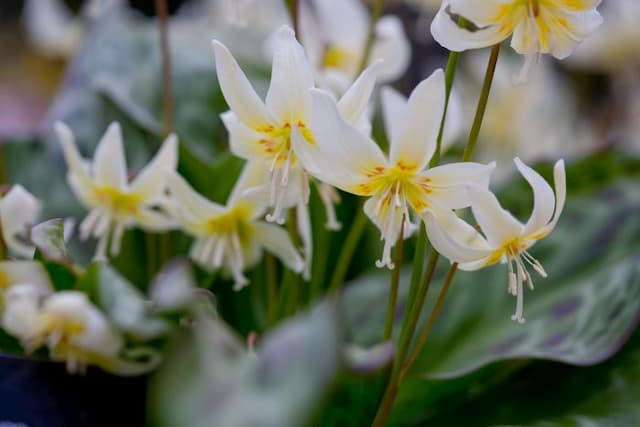Turkestan Tulip Tulipa turkestanica (15)

ABOUT
The plant commonly known as Turkestan tulip boasts a striking appearance often celebrated for its ornamental qualities. This tulip variety displays a cluster of star-shaped flowers, each composed of several pointed petals that gracefully arch outward, resembling a starburst. These blooms exhibit a creamy to light yellow color, often accented with a soft, canary-like glow at the base, creating a gentle gradient of warm hues. The flowers, characterized by their cheerful demeanor, are nestled atop slender green stems, which elegantly support the dainty blossoms. The stems emerge from a base of linear foliage, green in color, with leaves that may have a slight grey-blue tinge, contributing to the plant's overall delicate texture. In the very center of the flowers, one might notice reproductive structures, with pollen-laden stamens reaching outward, surrounded by a central, often darker colored pistil, inviting pollinators to visit. The Turkestan tulip's flowers have a refined yet wild beauty that can evoke the feel of a meadow in spring when in full display, adding a touch of natural elegance to any environment in which they are placed.
About this plant
 Names
NamesFamily
Liliaceae
Synonyms
Turkestan Tulip, Turkistan Tulip
Common names
Tulipa biflora var. turkestanica, Tulipa dasystemon, Tulipa dasystemon subsp. turkestanica, Tulipa latifolia, Tulipa orithyia, Tulipa turkestanica Regel.
 Toxicity
ToxicityTo humans
The plant commonly known as Turkestan tulip (Tulipa turkestanica) is not typically considered highly toxic to humans. However, as with many members of the Liliaceae family, it can have toxic properties if ingested. Eating parts of the Turkestan tulip, particularly the bulbs, may cause stomach upset, nausea, vomiting, or diarrhea. In very rare cases, more severe symptoms such as dizziness, difficulty breathing, or cardiac issues may occur. Handling the bulbs may also cause skin irritation in some individuals due to the presence of allergenic lactones. It is advisable to avoid ingesting any part of the plant and to use gloves when handling it if you have sensitive skin.
To pets
The Turkestan tulip (Tulipa turkestanica) can be toxic to pets if ingested, especially cats and dogs. The plant contains allergenic lactones and other compounds that can cause gastrointestinal upset, including symptoms such as vomiting, diarrhea, hypersalivation, and lethargy. The most poisonous part of the plant is the bulb. Ingestion of the bulb could potentially result in more severe symptoms, including an increase in heart rate, changes in respiration, and possibly convulsions if consumed in large quantities. If a pet ingests any part of the Turkestan tulip, it is important to seek veterinary care promptly.
 Characteristics
CharacteristicsLife cycle
Perennials
Foliage type
Deciduous
Color of leaves
Green
Flower color
White
Height
6 inches (15 cm)
Spread
6 inches (15 cm)
Plant type
Bulb
Hardiness zones
4
Native area
Central Asia
Benefits
 General Benefits
General Benefits- Ornamental value: Tulipa turkestanica, commonly known as Turkestan tulip, has aesthetic appeal with its attractive flowers, enhancing the visual beauty of gardens and landscapes.
- Pollinator attraction: The blooms of the Turkestan tulip attract bees and other pollinators, which are essential for the pollination of many plants and crops.
- Low maintenance: Turkestan tulips are relatively easy to care for, requiring minimal attention once planted, making them suitable for many gardeners, including beginners.
- Drought tolerance: Once established, these tulips are quite tolerant to periods of drought, which makes them suitable for xeriscaping or gardens with limited water availability.
- Adaptability: Turkestan tulip can adapt to a range of soil types, although they prefer well-drained soil, which allows them to be planted in a variety of garden settings.
- Seasonal interest: With their early spring blooming, Turkestan tulips provide an early splash of color, often when little else has started to flower in the garden.
 Medical Properties
Medical Properties- Antipyretic: May be used to reduce fever.
- Diuretic: Could help increase the passing of urine.
- Emmenagogue: May have properties that stimulate menstrual flow.
- Febrifuge: Potentially used to relieve fever.
 Air-purifying Qualities
Air-purifying QualitiesThis plant is not specifically known for air purifying qualities.
 Other Uses
Other Uses- Tulipa turkestanica bulbs can be ground into flour and used as a supplemental starch in cooking and baking.
- The strong fibers of the plant's stem can be used to make natural twine or cordage for garden use.
- Petals of the Tulipa turkestanica can be used to create natural dyes for fabrics or paper.
- Due to their bright and attractive colors, the petals can be used as a component in potpourri mixtures.
- When dried, the stems and leaves can be incorporated into natural crafts, such as wreaths or basketry.
- The plant can serve as a living mulch, with its dense foliage suppressing weeds in garden beds.
- Tulipa turkestanica can be grown as a companion plant to deter certain pests in vegetable gardens.
- The flowers can be used in the culinary arts as edible garnish for salads and desserts.
- They can be pressed or used in floral arrangements for educational purposes such as botanical studies.
- The seed pods can be collected and used for ornamental purposes in dried flower arrangements.
Interesting Facts
 Feng Shui
Feng ShuiThe Turkestan Tulip is not used in Feng Shui practice.
 Zodiac Sign Compitability
Zodiac Sign CompitabilityThe Turkestan Tulip is not used in astrology practice.
 Plant Symbolism
Plant Symbolism- Perfect Love: Tulips are often associated with perfect, enduring love between partners or family members.
- Ephemeral Beauty: As tulips have a relatively short bloom time, they can represent the fleeting nature of beauty.
- Rebirth: Representing spring, tulips can symbolize rebirth and renewal.
- Charity: In some cultural traditions, tulips are considered a symbol of charitable feelings and benevolence.
- Fame: Their bright presence in a garden can symbolize one's desire for fame or to be noticed.
 Water
WaterTurkistan tulip should be watered moderately during its growing season in spring, after which it requires a dry period while dormant. Typically, you would water these bulbs once a week with about an inch of water, ensuring the soil is moist but not waterlogged. During their dormancy, after the foliage has died back, cease watering altogether to prevent bulb rot. It is important to avoid over-watering as this can lead to fungal diseases and bulb decay.
 Light
LightTurkistan tulip thrives in full to partial sunlight, flourishing in bright conditions that mimic their native mountainous habitat. A spot that receives at least six hours of direct sunlight per day is ideal. They can tolerate some light afternoon shade but too much can result in poor bloom development.
 Temperature
TemperatureTurkistan tulip prefers cool to moderate temperatures, with an ideal temperature range between 60°F to 70°F during its active growth period. They can survive minimum temperatures as low as 35°F but should not be exposed to temperatures below freezing. Ideally, the dormant bulbs should be sheltered from excessive summer heat to mimic their natural cycle.
 Pruning
PruningPruning Turkistan tulip is generally not necessary for health or flowering, as they are bulbs. However, after the blooms have faded, you can deadhead the flowers to prevent seed formation. The foliage should be left intact until it has yellowed and died back naturally to ensure the bulbs can store energy for the next season.
 Cleaning
CleaningNot needed
 Soil
SoilTurkestan tulips thrive in well-draining, sandy or loamy soil with a neutral to slightly alkaline pH between 6.5 and 7.5. A mix of two-thirds sandy soil and one-third compost or well-rotted manure will provide the ideal growing conditions for these bulbs.
 Repotting
RepottingTurkestan tulips typically do not require frequent repotting. They should be replanted every 3-5 years or when the bulbs become overcrowded in their current space, ideally in the fall.
 Humidity & Misting
Humidity & MistingTurkestan tulips prefer a dry climate and do not require high humidity levels; they are tolerant of low-humidity environments typically found in temperate regions.
 Suitable locations
Suitable locationsIndoor
Place in bright, indirect light with cool temps.
Outdoor
Plant in well-drained soil; full sun to partial shade.
Hardiness zone
3-9 USDA
 Life cycle
Life cycleThe life of Turkestan tulip (Tulipa turkestanica) begins with a bulb, which remains dormant underground during the hot and dry summer months. In autumn, with cooler temperatures and increased moisture, the bulb activates and roots start to develop. The plant emerges in spring, with leaves growing first, followed by the characteristic white or yellow flowers with a variable number of petals and a central boss of yellow stamens. After pollination, typically by insects, the flowers produce capsules containing seeds. Once the seeds mature, they are dispersed by wind or animals. Finally, the above-ground parts of the plant die back after seed dispersal, and the cycle restarts with the bulb entering another period of dormancy until the next autumn.
 Propogation
PropogationPropogation time
Spring
Tulipa turkestanica, commonly known as Turkestan tulip, is generally propagated through bulb division. This propagation is most successfully undertaken in the fall season. To propagate, you first carefully lift the tulip bulbs from the soil after the foliage has died back and the bulbs have entered dormancy. Gently clean the soil from the bulbs and remove any offsets from the parent bulb. These offsets are miniature bulbs that will grow and flower in subsequent seasons. The parent bulb and its offsets should be stored in a cool, dry place until planting time. Bulbs are typically planted about 6 to 8 inches (15 to 20 centimeters) deep and spaced approximately 4 to 6 inches (10 to 15 centimeters) apart, with pointed ends facing upwards to enable the new tulips to emerge from the ground the following spring.








